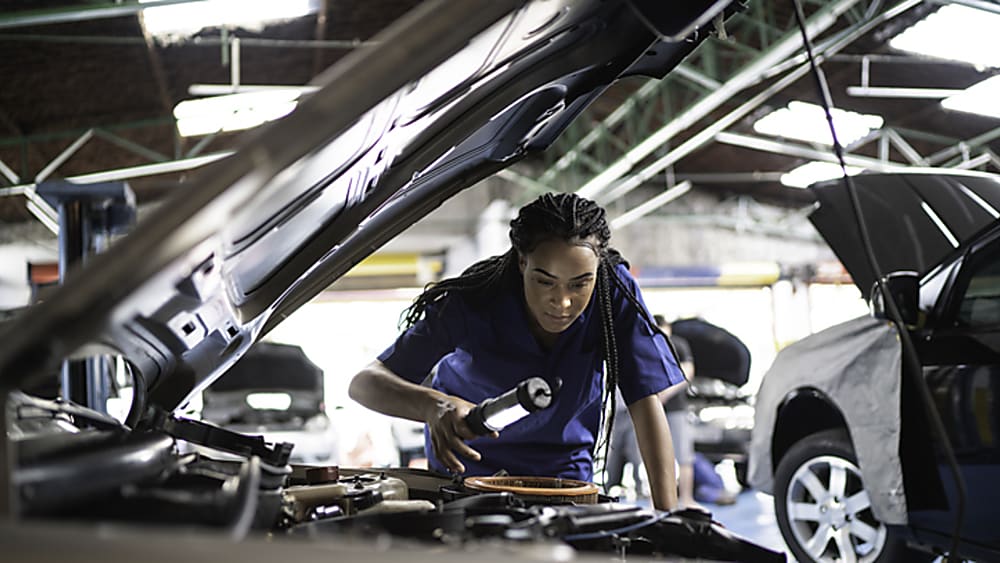Tire Maintenance & Safety
Safe Driving Tips for Teens & New Parents | SimpleTire

Free shipping
Best price guarantee
Special pricing
Financing with Resolve
Easy returns
Tire Maintenance & Safety


Ensuring the safety of teen drivers is a top priority for parents and guardians. The combination of inexperience, distractions, and a sense of invincibility can make the early years of driving particularly risky.
According to the Centers for Disease Control and Prevention, drivers aged 16-19 are more likely to be involved in a motor vehicle crash than any other age group. This sobering statistic underscores the importance of equipping teens with the knowledge and skills they need to navigate the roads safely.
Parents play a crucial role in guiding their teens through the learning process and setting a strong foundation for lifelong safe driving habits. By taking an active role in their teen's driving education and leading by example, parents can help mitigate the risks and ensure their teen becomes a responsible and confident driver.
Teen driving safety is paramount due to the heightened risks young drivers face on the road. Inexperience, combined with a propensity for distraction and a still-developing sense of judgment, contributes to the alarming statistics surrounding teen driver accidents.
The consequences of unsafe driving can be devastating—not only for the teen driver but also for their passengers, other road users, and their families. Beyond the potential for physical harm, accidents can also lead to emotional trauma, legal repercussions, and financial burdens.
Investing time and effort into teen driving safety is an investment in the future. By instilling good habits and a strong sense of responsibility from the start, parents can help their teens become safer drivers for life. This not only benefits the individual teen but also contributes to safer roads for everyone.
Creating an encouraging atmosphere at home is key to promoting safe driving habits for teens and new parents. Establishing an environment where safety is prioritized enables open discussions about driving experiences and potential challenges. This supportive setting helps new drivers feel comfortable sharing their thoughts, leading to better understanding and improvement.
Fostering a safe driving culture involves consistent communication about the importance of road safety. Parents should engage their teens in discussions about safe driving practices, emphasizing the significance of following traffic laws and using seat belts. Explaining the reasons behind these practices—such as reducing the risk of accidents—can help teens appreciate their value. Making safety a regular conversation topic emphasizes its importance.
Promoting open communication allows teens to express their thoughts on driving experiences, promoting learning and growth. This dialogue provides an opportunity for parents to offer guidance, reinforce positive driving behaviors, and address concerns. Maintaining a supportive and approachable demeanor encourages teens to seek advice or discuss mistakes, fostering trust essential for ongoing development.
By creating an environment that values open communication and safety, parents can guide their teens toward becoming conscientious and skilled drivers. This not only benefits individual families but also enhances safety for all road users.

Establishing a framework of expectations is essential for guiding teens toward responsible driving. Parents should introduce well-defined protocols—such as designated curfews, restrictions on the number of passengers, and a complete ban on mobile phone use while behind the wheel. These protocols serve as preventative measures, addressing common risks that inexperienced drivers face. For example, reducing the number of passengers helps minimize distractions, while curfews limit exposure to high-risk driving conditions like nighttime travel.
Engaging in transparent discussions about these guidelines and the rationale behind them can reinforce their importance. Teens need to grasp why such measures are necessary—whether it's about enhancing safety or adhering to legal standards. Parents can explain how these protocols are designed to protect them, using concrete examples or relevant data to illustrate potential hazards. This approach not only fosters understanding but also encourages teens to adopt safe driving principles willingly.
Underscoring the role of these expectations in ensuring safety can leave a lasting impression. When teens see the connection between rules and their overall well-being on the road, they are more inclined to comply. By consistently linking guidelines to safety outcomes, parents can instill a sense of responsibility and awareness in their teens, promoting a culture of conscientious driving.
Guided experience is vital for teens to acquire the skills essential for safe driving. Devoting considerable time to overseeing your teen in diverse driving situations helps them gain assurance and adaptability. Start by getting them accustomed to familiar roads and progressively introduce more demanding settings like busy highways, congested city streets, and rural routes. This gradual approach allows teens to encounter a variety of situations, from handling heavy traffic to maneuvering open roads with fewer distractions.
Cultivating skills in different settings is key for comprehensive learning. On highways, focus on the significance of maintaining safe speeds and appropriate distances between vehicles. In urban areas, practice navigating intersections, recognizing traffic signals, and staying alert to pedestrians and cyclists. Rural roads offer the chance to manage unpredictable conditions like narrow lanes or sharp bends. Each environment presents distinct challenges that contribute to a well-rounded driving education.
As your teen gains confidence, incrementally increase the complexity of driving scenarios. This may include exposure to challenging weather conditions, nighttime driving, and varying traffic patterns. Encourage applying concepts learned during practice, like adjusting speed for weather or using headlights effectively at night. By gradually introducing complexity, teens can advance from basic skills to proficient driving techniques, equipping them with the confidence and competence required for safe road navigation.
Identifying and reducing distractions is a crucial component of educating teen drivers. Everyday actions—such as glancing at a phone, snacking, or fiddling with the stereo—can significantly divert focus from driving and elevate the chance of an accident. Phone use, especially, poses a triple threat by taking eyes, hands, and thoughts away from driving. By addressing these prevalent issues, parents can guide teens to recognize and steer clear of behaviors that endanger their safety.
Utilizing real-world stories and data can effectively convey the risks associated with distracted driving. For example, studies highlight that even brief moments of inattention can lead to severe outcomes. Sharing narratives of incidents caused by distractions personalizes the danger, making it more relatable for teens. Presenting data—like the fact that young drivers are more prone to crashes due to distractions—backs up the message with factual support.
Promoting habits that eliminate distractions is key to fostering mindful driving practices. Teens should establish a pre-driving routine that addresses potential distractions. This might involve setting navigation, choosing music, and ensuring all necessary items are organized before setting off. Encouraging these behaviors from the start helps instill a safety-first mindset, contributing to a culture of responsible driving.
Seat belts are crucial for minimizing risks on the road, acting as a critical safety measure during any journey. Encouraging teens to buckle up every time they get into a vehicle instills this practice as an automatic habit. Evidence indicates that wearing a seat belt can drastically reduce the likelihood of serious injuries in a collision. By sharing these insights, parents can highlight the necessity of seat belts as a fundamental aspect of vehicle safety.
Understanding the mechanics of seat belts can help teens appreciate their value beyond just a rule to follow. Designed to absorb impact energy and restrain occupants securely, seat belts prevent occupants from being thrown inside the car or ejected. This effective distribution of force across the body’s more resilient areas reduces the chance of injury. Providing this explanation helps teens grasp why consistent seat belt use is essential for their protection.
Parents are pivotal in reinforcing this behavior by demonstrating a consistent commitment to seat belt use. By making it a visible and consistent action, they set a strong example that teens are likely to emulate. When parents prioritize their safety by always fastening their seat belts, they send a clear message about its importance, helping to ingrain this habit in their teens from the outset.
Parents can effectively instill safe driving habits by demonstrating consistent adherence to traffic rules. Exhibiting behaviors like maintaining appropriate speeds and signaling turns reinforces the significance of these actions to teens. When parents model these practices, they underscore the importance of vigilance and rule-following on the road, offering a living example of responsible driving.
Engaging teens in discussions about navigating various road scenarios can enhance their understanding and preparedness. Sharing insights on managing space between vehicles, mastering right-of-way at intersections, and adjusting speed for differing conditions equips teens with practical strategies for real-world driving. These conversations provide them with a set of tools to navigate unexpected situations safely and confidently.
Creating an environment that encourages questions and seeks clarity is crucial for developing a teen’s driving proficiency. Whether they need advice on handling specific road challenges or understanding rules, fostering an atmosphere of support helps them grow as competent drivers. Parents can share their own experiences, offering relatable insights and fostering a deeper understanding of safe driving practices. This exchange not only strengthens the parent-teen bond but also empowers teens to approach driving with a proactive and informed perspective.

Understanding the essentials of tire care is crucial for maintaining safety on the road. Regular tire maintenance involves checking the pressure and assessing tread depth, both key factors for optimal vehicle performance. Consistently monitoring tire pressure ensures that tires remain properly inflated, enhancing fuel efficiency and improving handling. Adequate tread depth is vital for maintaining traction, especially in wet conditions, helping prevent issues like hydroplaning. Teaching teens to integrate these checks into their routine fosters a proactive attitude toward vehicle upkeep and safety.
Properly maintained tires play a significant role in overall vehicle safety. Tires are the vehicle’s primary connection to the road, and their condition directly affects driving dynamics. Ensuring correct inflation and sufficient tread depth contributes to better control, effective braking, and stability, particularly in challenging weather conditions. By highlighting these aspects, parents can help teens grasp the direct link between tire maintenance and their safety, as well as that of others on the road.
Encouraging regular tire inspections as part of routine car care instills good habits in new drivers. This includes identifying visible signs of damage, such as cuts or bulges, and ensuring even wear across all tires. Teens should also learn to recognize when professional evaluation is necessary, promoting a proactive approach to vehicle maintenance. Integrating tire care into regular driving habits helps teens develop a comprehensive approach to car safety, equipping them to handle driving challenges more effectively.
At SimpleTire, we understand the importance of equipping teens with the knowledge and skills they need to stay safe on the road. We are committed to being a resource for parents and guardians as they guide their teens through the learning process. If you're looking for high-quality tires at competitive prices, shop for tires online with us and find the best deals to keep your teen safe on the road.
Search By